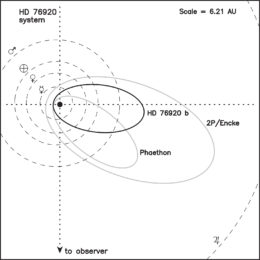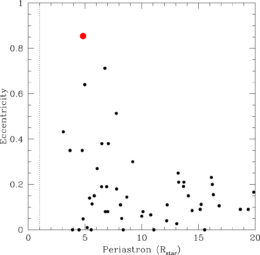As part of a major survey of evolved stars, scientists have discovered the most eccentric planet known to orbit a giant. What can we learn from this unusual object before it’s eventually consumed by its host?
Planetary Diversity

An example of the diversity of just a few of the planetary systems discovered by the Kepler mission. [NASA]
As we observed the first exoplanets and learned about their properties, however, it quickly became apparent that most other systems don’t resemble our own. The more exoplanets we observe, the more we become aware of the diversity of planetary systems — with planet compositions, masses, and orbits unlike any in the solar system.

Orbit of HD 76920b, oriented properly and overlaid with the solar system inner planets’ orbits to scale. A comet and asteroid from our solar system are shown as having comparably eccentric orbits. [Wittenmyer et al. 2017]
Relative Sizes Matter
Some systems are easier to study than others. Since exoplanet detection and characterization techniques rely on looking for the imprint of planets on stellar signals, systems consisting of a small star and large planet are favored. For this reason, exoplanets orbiting solar-like or dwarf stars are especially well studied — but we don’t have nearly as much information about planets orbiting massive, hot stars.
To combat this lack of data, several teams have begun surveys particularly targeting evolved, massive stars. One of these is known as the Pan-Pacific Planet Search, a survey that uses the 3.9m Anglo-Australian Telescope in Australia to study the spectra of metal-rich subgiants in the southern hemisphere. Fresh among the discoveries from this survey is a planet orbiting HD 76920, reported on in a recent publication led by Robert Wittenmyer (University of Southern Queensland and University of New South Wales, Australia).
An Extreme Orbit

Orbital eccentricity vs. planet’s periastron distance for the 116 confirmed planets orbiting giant stars. HD 76920b, the most eccentric of them, is shown with the red dot. [Wittenmyer et al. 2017]
How did HD 76920b achieve its extreme orbit? The go-to explanation for such an orbit is gravitational influence from a distant, massive stellar companion — and yet the authors find no evidence in their observations for a second star in the system. Instead, the team suggests that HD 76020b arrived on its current orbit via planet–planet scattering interactions earlier in the system’s lifetime.
Toasty Future
Lastly, Wittenmyer and collaborators use modeling to explore HD 76020b’s future. This planet’s orbit is already so extreme that it nearly skims the surface of its host, dipping to within 4 stellar radii of the star’s surface at its closest approach. The authors show that the planet will be engulfed by its host on a timescale of ~100 million years due to a combination of the star’s expanding radius and tidal interactions.
Gathering more observations of this extreme planet — and hunting for others like it — will help us to continue to learn about the formation and evolution of the diverse planetary systems our universe houses.
Citation
Robert A. Wittenmyer et al 2017 AJ 154 274. doi:10.3847/1538-3881/aa9894



1 Comment
Pingback: another really wacky planet from AAS